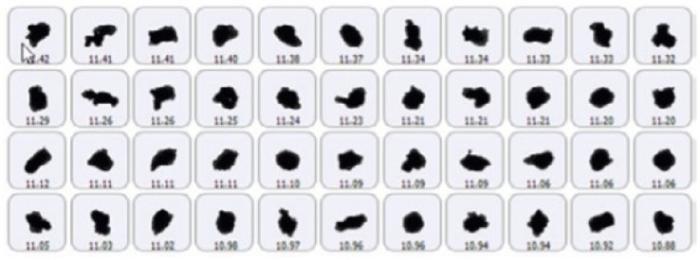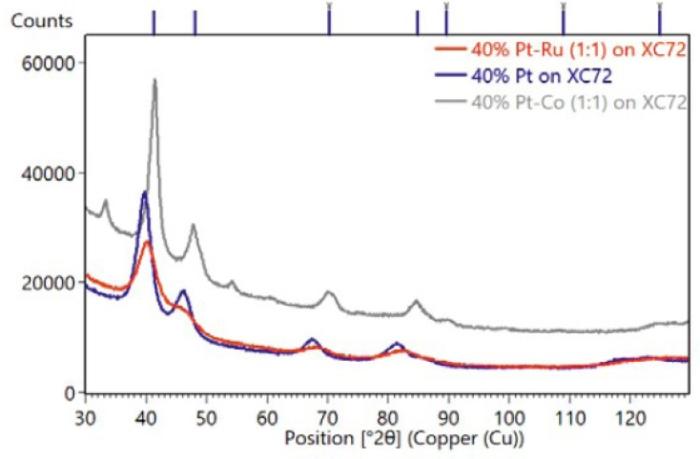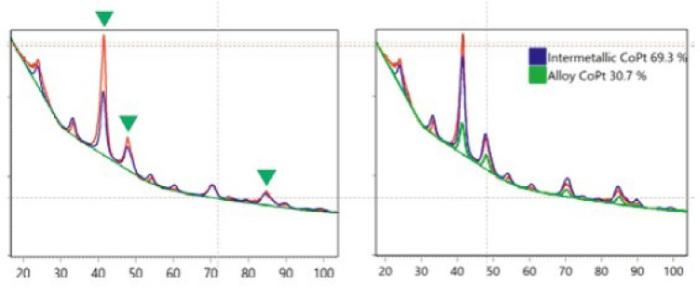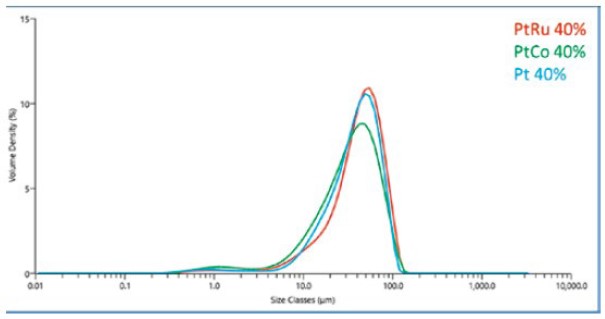Malvern Panalytical의 'Characterization of electrocatalysts used in PEM electrolyzers and fuel cells'에 관한 응용자료의 주요 내용은 다음과 같다.
지난 사이언스21 6월호에 소개된 'Characterization of electrocatalysts used in PEM electrolyzers and fuel cells' 시리즈에 대한 내용을 이어서 다음과 같이 소개하고자 한다.
Figure 6. Partial catalog of the Pt/C catalyst powders imaged by the Morphologi 4.
Characterization of Alloy Catalysts
In the section above, catalytic powders using pure Pt were analyzed. These techniques can also be used to measure catalytic alloys. Some alloys, such as platinum-cobalt(PtCo), are being studied with the aim of reducing their costs. by lowering the amount of precious metal required to produce PEMFCs. Others, such as platinum-ruthenium(PtRu), are being investigated with the aim of creating reversible PEMFCs that can be used as electrolyzers for H2 production, and as fuel cells to generate electricity from H2.
In addition to the analysis related to crystallite size and lattice parameters discussed above, XRD can be used to confirm the phase of catalytic alloys. Figure 7 compares the diffraction patterns of PtRu, PtCo, and Pt catalysts loaded at 40% on Vulcan XC-72 carbon black support particles. The diffraction pattern of PtRu indicates that it had an FCC crystal structure, like that of Pt, whereas the diffraction pattern of PtCo reveals a primitive tetragonal crystal structure. This is an important observation, since PtCo can be produced in FCC, facecentered tetragonal, and primitive tetragonal polymorphs.
The crystal structure significantly affects the catalytic activity as it determines the type of exposed facet, which strongly differ from one another in terms of surface energy.
Rietveld refinement of the PtCo/C diffraction pattern, shown in Figure 8, revealed that modeling the catalyst as a purely tetragonal PtCo does not satisfactorily reproduce the experimental data. The fundamental reflections those shared between the cubic alloy phase and the tetragonal intermetallic phase have undercalculated intensities. A satisfactory fit of the experimental XRD data is only produced when the sample is modeled as a mixture of 69% tetragonal PtCo intermetallic and 31% cubic PtCo alloy. This phase mixture has significant implications for the performance of this catalytic powder.
The volume average crystallite size of the PtCo alloy was 5nm, larger than that of the pure Pt(3nm) and Pt-Ru(2nm).
XRF analysis of loose powders, performed using standardless quantification with Omnian analysis software, determined that the mass ratio of the PtCo alloy was 0.28, close to the nominal value of 0.3. Likewise, the calculated mass ratio of the PtRu alloy was 0.47, close to the nominal value of 0.52. Laser diffraction analysis revealed that the C-support particle agglomerates had similar sizes to catalytic powders made with all three alloys, as shown in Figure 9.
Figure 7. X-ray powder diffraction data collected with an Aeris benchtop X-ray diffractometer from samples of 40%-Pt-loaded catalytic powder with three different Pt alloys(Pt, PtRu, PtCo) on Vulcan XC-72 carbon black support particles.
Figure 8. Comparison of Rietveld modeling of 40%-loaded PtCo on C-support catalytic powder, when modeled as pure tetragonal PtCo(left) and as a mixture of the tetragonal intermetallic and cubic alloy(right).
Figure 9. Laser diffraction data measured with a Mastersizer 3000 for catalytic powders consisting of 40% loading of PtRu on C, Pt on C, and PtCu on C.
Conclusion
The studies outlined above show that XRD, XRF, laser diffraction, and automated image analysis can all be effective techniques for analyzing various properties of pure and alloyed Pt nanoparticles supported on a C matrix.
XRD is particularly suited to analyzing crystallite size, strain, lattice parameters, and phase composition. XRF delivers precise measurements for Pt loading, as well as effective analysis of Pt catalyst purity and Pt alloy composition. Laser diffraction is ideal for analyzing the particle size of C-support that influences the Pt dispersion and porosity in the catalytic active compound. Finally, while morphological imaging provides limited insight into the particle size, it is valuable in providing images of individual agglomerates to enable shape analysis. Together, these techniques enable manufacturers to optimize both the cost and performance of systems based on PEM technology by maximizing catalyst efficiency, reducing the amount of Pt required, or developing Pt-based alloy nanoparticles.
Product related:
•Mastersizer 3000
•Epsilon 1
•Morphologi 4
•Aeris
Technology
•Laser Diffraction
•Image Analysis
•XRD
•XRF
Malvern Panalytical의 'Mastersizer 3000, Epsilon 1, Morphologi 4 and Aeris'에 대한 상세한 내용은 Reference(참고자료)를 통하여 확인할 수 있다.
Reference(참고자료): 말번 파날리티칼 응용노트
Model Name(모델명): Mastersizer 3000, Epsilon 1, Morphologi 4 and Aeris
The Person in Charge(담당자): Hyunjung Gu
Maker(제조사): Malvern Panalytical
Country of Origin(원산지): UK, Netherlands
Mail inquiry: info.korea@malvern.com
Data Services(자료제공): Malvern Panalytical Korea
<이 기사는 사이언스21 매거진 2022년 7월호에 게재 되었습니다.>







